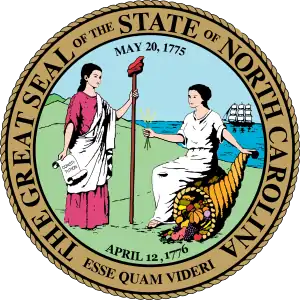List of metropolitan areas of North Carolina

Charlotte, largest city and metropolitan area

Raleigh, second largest metropolitan area

Greensboro, third largest metropolitan area

Winston-Salem, fourth largest metropolitan area
| Rank | Metropolitan Statistical Area | Population 2019 estimates[1] |
|---|---|---|
| 1 | Charlotte | 2,225,648 |
| 2 | Raleigh | 1,390,785 |
| 3 | Greensboro | 771,851 |
| 4 | Winston-Salem | 676,008 |
| 5 | Durham | 644,367 |
| 6 | Fayetteville | 526,719 |
| 7 | Asheville | 462,680 |
| 8 | Hickory | 369,711 |
| 9 | Wilmington | 297,533 |
| 10 | Jacksonville | 197,938 |
| 11 | Greenville | 180,742 |
| 12 | Burlington | 169,509 |
| 13 | Rocky Mount | 145,770 |
| 14 | Bolivia | 136,744 |
| 15 | New Bern | 124,284 |
| 16 | Goldsboro | 123,131 |
| 17 | Currituck | 49,355 |
| 7,615,286 |
| Rank | Combined Statistical Area | Population 2012 estimates[2] |
|---|---|---|
| 1 | Charlotte-Concord-Gastonia | 2,386,401 |
| 2 | Raleigh-Durham-Chapel Hill | 2,079,687 |
| 3 | Greensboro–Winston-Salem–High Point | 1,689,151 |
| 4 | Fayetteville–Lumberton–Laurinburg | 854,826 |
| 5 | Asheville-Brevard | 542,821 |
| 6 | Rocky Mount-Wilson-Roanoke Rapids | 297,064 |
| 7 | Greenville-New Bern | 283,685 |
| 8 | New Bern | 193,757 |
| 9 | Kill Devil Hills | 138,917 |
| 10 | Oak Island | 136,744 |
See also
- Table of United States Metropolitan Statistical Areas
- Table of United States Combined Statistical Areas
References
- "popest/data/metro/totals/2012/tables/CBSA-EST2012-01". census.gov. Archived from the original on 2013-04-01. Retrieved 2014-04-19.
- "popest/data/metro/totals/2012/tables/CBSA-EST2012-02". census.gov. Archived from the original on 2013-05-17. Retrieved 2014-04-19.
This article is issued from Wikipedia. The text is licensed under Creative Commons - Attribution - Sharealike. Additional terms may apply for the media files.

